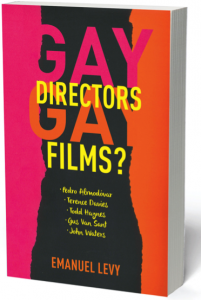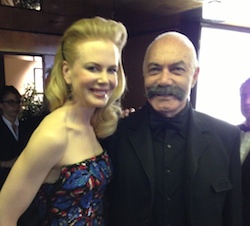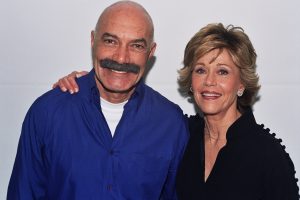Hard to believe, but gay screen characters have been with us from the very beginning of movies–even during the Production Code years, when “sex perversion” was explicitly forbidden.
It’s therefore both appropriate and timely that a landmark documentary, The Celluloid Closet, Rob Epstein and Jeffrey Friedman’s engrossing chronicle of the depiction of gays and lesbians in the Hollywood cinema, would be made in a year that celebrates the first centennial of movies.
Fraught with illuminating insights about the “permissible” and “forbidden” in American culture–and at the same time vastly entertaining–it’s one of the best documentaries I have seen in a decade.
Chronicling hundreds of mainstream American movies, the film offers a definitive history of the screen perception of lesbians and gay men, from comic sissies to lesbian vampires, from pathetic queens to sadistic predators. As we move along the decades, the tone of the movies shifts from the light and humorous to the heinous and abominable to the heartening and a bit more liberating.
The filmmakers work with great footage–each of the clips is impeccably chosen and brilliantly illustrated. But the great assembly of images is only one element that contributes to the film’s richness. The directors have shrewdly decided not to get overly polemic–the movie is not an angry political diatribe against Hollywood. Instead, witty, often campy commentary by seminal gay figures, such as Gore Vidal and Quentin Crisp, and interviews with directors and actors, such as William Wyler, Tony Curtis, Susan Sarandon, and Tom Hanks, shed light on the context in which these films were made and what they meant for both gay and straight viewers.
In her narration, Lily Tomlin points out that, for the most part, homosexuality has been treated by Hollywood as something to get easy laughs from the audience and inspire fear amongst gays by condemning their deviant lifestyle. Hollywood’s first gay stock character to come under scrutiny is the sissy, described as one of “nature’s mistakes.” As Quentin Crisp notes, sissy characters often flirted with transvestism, which, unlike the present time, invariably was played for humor. Yet women in male drag were a totally different story. High on the list of lesbian icons are Marlene Dietrich in a man’s suit, kissing a woman in the mouth, in Morocco and Greta Garbo as Swedish monarch in Queen Christina.
During the studio system, the Hays Code’s division of films into acceptable, morally objectionable and condemned categories meant that most gay characters were treated negatively. Gay male characters became miserable, pitiable or doomed, like Tom Lee’s role in Tea and Sympathy and Sal Mineo’s Plato in Rebel Without a Cause. Our knowledge of Mineo’s homosexuality and the tragic way he ended his life make watching his “love” scene with James Dean all the more painful.
Moving into the 1950s, the documentary heralds the arrival of tough lesbians behind bars (Hope Emerson as a tough ward in Caged), but also the sleek socialite model, like Lauren Bacall in Young Man with a Horn, interpreted by screenwriter Jay Presson Allen (Cabaret) as a warning for women to get back to the kitchen.
During the Golden Age, censors set about removing any obvious homosexual elements from the movies, but traces often remained. In one of the film’s best sequences, Gore Vidal hilariously recounts his introduction of a gay frisson between Ben-Hur and Massala into his Ben-Hur scenario. Knowing the conservative, humorless politics of his lead actor, Charlton Heston, director William Wyler consented, but asked Vidale not to tell him about it, though co-star Stephen Boyd was aware of it. Watching the scene today, with Boyd campily looking Heston straight in the eyes, while holding his hand, gives the scene an entirely new meaning. Similarly, Tony Curtis wryly explains the deletion of his erotic hot-tub scene with Lawrence Olivier in Spartacus (The scene was reinserted in later versions of the picture).
As the film moves through time, it shows a growing gay visibility in Hollywood, in front and behind the cameras. In the l970s, new voices began challenging the prevailing stigmas attached to gays, actively fighting for a more realistic representation. Tom Hanks discusses his Oscar-winning role in Philadelphia, and Susan Sarandon throws new light into her sex scenes with Catherine Deneuve in The Hunger, and her Butch Cassidy and the Sundance Kid-like relationship with Geena Davis in Thelma & Louise.
In addition to the more objective chronicle of Hollywood’s treatment of gays, the movie offers a more subjective account of “the gay look”–of how gay and lesbian viewers watch Hollywood movies. The tendency to read against the grain, i.e. between the lines, to see meanings not just in the text, but also in the subtext. Independent filmmaker Jan Oxenberg (Thank You and Goodnight) discusses how lesbians were starved for imagery of their real lives; a distorted movie like The Children’s Hour impeded the acceptance of lesbianism. Playwright Paul Rudnick (Jeffrey) riotously deconstructs the campy scene in Gentlemen Prefer Blondes, where Jane Russell is surrounded by gorgeous men in a gym, but is totally ignored by them. Armistead Maupin offers personal observations of coming out and his friendship with Rock Hudson.
Interestingly edited, the film, which was written by Armistead Maupin (Tales of the City), benefits from Carter Burwell’s score and particularly from k.d. lang’s evocative rendition of the Doris Day evergreen “Secret Love” on the closing credits.
The Celluloid Closet takes a respectable place next to Epstein and Friedman’s two Oscar-winning gay films, The Times of Harvey Milk and Common Threads: Stories from the Quilt. On a more personal level, the movie serves as an eloquent tribute to Vito Russo, whose revolutionary l981 book (of the same title) provided the essential material for the new movie. I have no doubts that Russo, who died in l991 (and was one of the central figures in Common Threads), would have been pleased with this movie.















